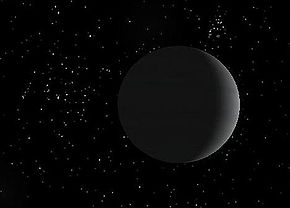 Simulated image of Mu Arae b | |
| Discovery | |
|---|---|
| Discovered by | Butler, Marcy |
| Discovery site | California, US |
| Discovery date | December 12, 2000 |
| Doppler Spectroscopy | |
| Orbital characteristics | |
| Apastron | 1.689 AU (252,700,000 km) |
| Periastron | 1.304 AU (195,100,000 km) |
| 1.497 AU (223,900,000 km)[1] | |
| Eccentricity | 0.128[1] |
| 643.25 ± 0.90[1] d 1.7611 y | |
| 2452365.6 ± 12.6[1] | |
| 22.0 ± 7.0[1] | |
| Semi-amplitude | 37.78 ± 0.40 |
| Star | Mu Arae |
Mu Arae b, often designated HD 160691 b, formally named Quijote /kiˈhoʊtiː/, is an exoplanet orbiting the star Mu Arae of the constellation Ara.
The planet is at least one and a half times the mass of Jupiter, and its orbital period is 643.25 days. The discovery of this planet was announced on December 12, 2002, and was originally thought to be on a highly eccentric orbit.[2] The latest models of Mu Arae planetary system, which has four known planets, give a lower eccentricity orbit.[1] Although the planet itself is likely to be a gas giant with no solid surface, the orbital distance of 1.497 astronomical units from its star puts it within the habitable zone of its planetary system. As a result, large satellites of the planet, if they exist, could potentially support life.[improper synthesis?] However, it may not receive enough ultraviolet light for abiogenesis to proceed.[3] Furthermore, it is not clear that Earth-size moons can actually be formed in the environment around a gas giant planet.[4]
- ^ a b c d e f Pepe, F.; Correia, A. C. M.; Mayor, M.; Tamuz, O.; et al. (2007). "The HARPS search for southern extra-solar planets. VIII. μ Arae, a system with four planets". Astronomy and Astrophysics. 462 (2): 769–776. arXiv:astro-ph/0608396. Bibcode:2007A&A...462..769P. doi:10.1051/0004-6361:20066194. S2CID 119071803.
- ^ Butler, R. Paul; Tinney, C. G.; Marcy, Geoffrey W.; Jones, Hugh R. A.; et al. (2001). "Two New Planets from the Anglo-Australian Planet Search". The Astrophysical Journal. 555 (1): 410–417. Bibcode:2001ApJ...555..410B. doi:10.1086/321467. hdl:2299/137. S2CID 122572834.
- ^ Buccino, Andrea P.; Lemarchand, Guillermo A.; Mauas, Pablo J. D. (2006). "Ultraviolet Radiation Constraints around the Circumstellar Habitable Zones". Icarus. 183 (2): 491–503. arXiv:astro-ph/0512291. Bibcode:2006Icar..183..491B. doi:10.1016/j.icarus.2006.03.007. S2CID 2241081.
- ^ Canup, R.; Ward, W. (2006). "A common mass scaling for satellite systems of gaseous planets". Nature. 441 (7095): 834–839. Bibcode:2006Natur.441..834C. doi:10.1038/nature04860. PMID 16778883. S2CID 4327454.